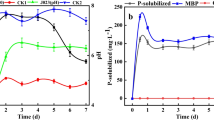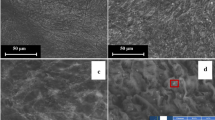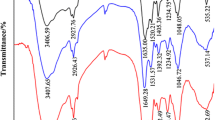Abstract
This study investigates the effectiveness and mechanism of decreasing the bioavailability of Pb in bacterial culture and in pot experiments of Pb-contaminated paddy soil by Alishewanella sp. WH16-1. The WH16-1 strain was isolated from mine soil and exhibited high resistances to many heavy metals, especially to Pb2+ (2070 mg/L) and Cr (VI) (2340 mg/L). During cultivation of the WH16-1 strain with the addition of 100 mg/L Pb2+, Pb2+ was precipitated, and 84.13 % of Pb2+ was removed in 72 h. The precipitant was observed by transmission electron microscopy (TEM) and further confirmed to be PbS by X-ray diffraction (XRD) and X-ray photoelectron spectroscopy (XPS). The WH16-1 strain was incubated in Pb2+-added paddy soil pot experiments for 60 days and compared with the uninoculated Pb2+-added paddy soil. Comparison showed that the exchangeable and carbonate-bound Pb in the paddy soil decreased by 14.04 and 10.69 % (P < 0.05), respectively. The Fe-Mn oxide-bound Pb, organic matter-bound Pb and the residual Pb increased by 4.47, 19.40, and 22.78 % (P < 0.05), respectively. Compared with the uninoculated Pb2+-added paddy soil, the dry weight of rice significantly increased by 28.59 %, and the Pb concentrations in rice, husk, leaves, and culms in Pb2+-added paddy soil pot experiment incubated with the WH16-1 strain significantly decreased by 26.18, 26.94, 26.61, and 25.56 % (P < 0.05), respectively. These results suggest that Alishewanella sp. WH16-1 can reduce the bioavailability of Pb in soil. This bacterium may be applicable for the biological stabilization of Pb in Pb-contaminated paddy soil.





Similar content being viewed by others
References
Administration of Quality Supervision, Inspection and Quarantine of China (AQSIQ). (2001). Safety qualification for agricultural product-safety requirements for non-environmental pollution vegetable (GB18406.1-2001) (in Chinese).
Alam, M. Z., Ahmad, S., & Malik, A. (2011). Prevalence of heavy metal resistance in bacteria isolated from tannery effluents and affected soil. Environmental Monitoring and Assessment, 178(1-4), 281–291.
Bian, B., suo Wu, H., Lv, L., Fan, Y., & Lu, H. (2015). Health risk assessment of metals in food crops and related soils amended with biogas slurry in Taihu Basin: perspective from field experiment. Environmental Science and Pollution Research, 22(18), 14358–14366.
Boudrahem, F., Aissani-Benissad, F., & Soualah, A. (2011). Adsorption of lead (II) from aqueous solution by using leaves of date trees as an adsorbent. Journal of Chemical & Engineering Data, 56(5), 1804–1812.
Chen, Y., Shen, Z., & Li, X. (2004). The use of vetiver grass (Vetiveria zizanioides) in the phytoremediation of soils contaminated with heavy metals. Applied Geochemistry, 19(10), 1553–1565.
Çolak, F., Atar, N., Yazıcıoğlu, D., & Olgun, A. (2011). Biosorption of lead from aqueous solutions by Bacillus strains possessing heavy-metal resistance. Chemical Engineering Journal, 173, 422–428.
Dudka, S., Piotrowska, M., & Chlopecka, A. (1994). Effect of elevated concentrations of Cd and Zn in soil on spring wheat yield and the metal contents of the plants. Water, Air, and Soil Pollution, 76(3-4), 333–341.
Friesl, W., Lombi, E., Horak, O., & Wenzel, W. W. (2003). Immobilization of heavy metals in soils using inorganic amendments in a greenhouse study. Journal of Plant Nutrition and Soil Science, 166(2), 191–196.
Gadd, G. M. (2010). Metals, minerals and microbes: geomicrobiology and bioremediation. Microbiology, 156(3), 609–643.
Hassen, A., Saidi, N., Cherif, M., & Boudabous, A. (1998). Resistance of environmental bacteria to heavy metals. Bioresource Technology, 64(1), 7–15.
Kamnev, A. A., Renou‐Gonnord, M. F., Antonyuk, L. P., Colina, M., Chernyshev, A. V., Frolov, I., & Ignatov, V. V. (1997). Spectroscopic characterization of the uptake of essential and xenobiotic metal cations in cells of the soil bacterium Azospirillum brasilense. Biochemistry and Molecular Biology International, 41(1), 123–130.
Kim, O. S., Cho, Y. J., Lee, K., Yoon, S. H., Kim, M., Na, H., & Chun, J. (2012). Introducing EzTaxon-e: a prokaryotic 16S rRNA gene sequence database with phylotypes that represent uncultured species. International Journal of Systematic and Evolutionary Microbiology, 62(3), 716–721.
Kuyucak, N., & Volesky, B. (1989). The mechanism of cobalt biosorption. Biotechnology and Bioengineering, 33(7), 823–831.
Liang, X., Xu, Y., Wang, L., Sun, Y., Lin, D., Sun, Y., & Wan, Q. (2013). Sorption of Pb 2+ on mercapto functionalized sepiolite. Chemosphere, 90(2), 548–555.
Liao, S., Liu, G., Zhu, D., Li, Y., Ren, L., & Cui, J. (2011). Characterization and properties of boron-doped aluminum hydroxide for Mn2+ adsorption and soil acidification. Environmental Earth Sciences, 62(5), 1047–1054.
Li, J., Wang, Q., Li, M., Yang, B., Shi, M., Guo, W., & Wang, G. (2015). Proteomics and genetics for identification of a bacterial antimonite oxidase in Agrobacterium tumefaciens. Environmental Science & Technology. doi:10.1021/es506318b.
Loukidou, M. X., Matis, K. A., Zouboulis, A. I., & Liakopoulou-Kyriakidou, M. (2003). Removal of As (V) from wastewaters by chemically modified fungal biomass. Water Research, 37(18), 4544–4552.
Luo, S., Xu, X., Zhou, G., Liu, C., Tang, Y., & Liu, Y. (2014). Amino siloxane oligomer-linked graphene oxide as an efficient adsorbent for removal of Pb (II) from wastewater. Journal of Hazardous Materials, 274, 145–155.
Márquez-Reyes, J. M., López-Chuken, U. J., Valdez-González, A., & Luna-Olvera, H. A. (2013). Removal of chromium and lead by a sulfate-reducing consortium using peat moss as carbon source. Bioresource Technology, 144, 128–134.
Ministry of Environmental Protection of China (MEP). (2008). Environmental quality standards for soils (GB15618-2008) (in Chinese).
Mozafari, M., & Moztarzadeh, F. (2010). Controllable synthesis, characterization and optical properties of colloidal PbS/gelatin core-shell nanocrystals. Journal of Colloid and Interface Science, 351(2), 442–448.
Mudhoo, A., Garg, V. K., & Wang, S. (2012). Removal of heavy metals by biosorption. Environmental Chemistry Letters, 10(2), 109–117.
Shim, J., Babu, A. G., Velmurugan, P., Shea, P. J., & Oh, B. T. (2014). Pseudomonas fluorescens JH 70-4 promotes Pb stabilization and early seedling growth of Sudan grass in contaminated mining site soil. Environmental Technology, 35(20), 2589–2596.
Shuman, L. M. (1999). Organic waste amendments effect on zinc fractions of two soils. Journal of Environmental Quality, 28(5), 1442–1447.
Siripornadulsil, S., & Siripornadulsil, W. (2013). Cadmium-tolerant bacteria reduce the uptake of cadmium in rice: potential for microbial bioremediation. Ecotoxicology and Environmental Safety, 94, 94–103.
Sreejalekshmi, K. G., Krishnan, K. A., & Anirudhan, T. S. (2009). Adsorption of Pb (II) and Pb (II)-citric acid on sawdust activated carbon: kinetic and equilibrium isotherm studies. Journal of Hazardous Materials, 161(2), 1506–1513.
Sun, Y., Li, Y., Xu, Y., Liang, X., & Wang, L. (2015). In situ stabilization remediation of cadmium (Cd) and lead (Pb) co-contaminated paddy soil using bentonite. Applied Clay Science, 105, 200–206.
Takahashi, M., Ohshima, Y., Nagata, K., & Furuta, S. (1993). Electrodeposition of PbS films from acidic solution. Journal of Electroanalytical Chemistry, 359(1), 281–286.
Tamura, K., Dudley, J., Nei, M., & Kumar, S. (2007). MEGA4: molecular evolutionary genetics analysis (MEGA) software version 4.0. Molecular Biology and Evolution, 24(8), 1596–1599.
Tessier, A., Campbell, P. G., & Bisson, M. (1979). Sequential extraction procedure for the speciation of particulate trace metals. Analytical Chemistry, 51(7), 844–851.
The Ministry of Environmental Protection and the Ministry of Land. (2014). The National Survey Bulletin Soil Pollution.
Thompson, J. D., Gibson, T. J., Plewniak, F., Jeanmougin, F., & Higgins, D. G. (1997). The CLUSTAL_X windows interface: flexible strategies for multiple sequence alignment aided by quality analysis tools. Nucleic Acids Research, 25(24), 4876–4882.
Uchimiya, M., Lima, I. M., Thomas Klasson, K., Chang, S., Wartelle, L. H., & Rodgers, J. E. (2010). Immobilization of heavy metal ions (CuII, CdII, NiII, and PbII) by broiler litter-derived biochars in water and soil. Journal of Agricultural and Food Chemistry, 58(9), 5538–5544.
Wilson, K. H., Blitchington, R. B., & Greene, R. C. (1990). Amplification of bacterial 16S ribosomal DNA with polymerase chain reaction. Journal of Clinical Microbiology, 28(9), 1942–1946.
Xiang, Y., Xiang, Y., Wang, L., & Zhang, Z. (2016). Effects of modified excess sludge on the growth of artemisia ordosica and transformation of heavy metals. Water, Air, & Soil Pollution, 227(4), 1–9.
Yu, D., Wang, D., Meng, Z., Lu, J., & Qian, Y. (2002). Synthesis of closed PbS nanowires with regular geometric morphologies. Journal of Materials Chemistry, 12(3), 403–405.
Zeng, L., Liao, M., Chen, C., & Huang, C. (2007). Effects of lead contamination on soil enzymatic activities, microbial biomass, and rice physiological indices in soil–lead–rice (Oryza sativa L.) system. Ecotoxicology and Environmental Safety, 67, 67–74.
Zouboulis, A. I., Loukidou, M. X., & Matis, K. A. (2004). Biosorption of toxic metals from aqueous solutions by bacteria strains isolated from metal-polluted soils. Process Biochemistry, 39(8), 909–916.
Acknowledgments
This project was supported by the Fundamental Research Funds for the Central Universities (Grant No. 2013PY122) and the National Natural Science Foundation of China (Grant No. 41171213 and 31010103903).
Author information
Authors and Affiliations
Corresponding author
Rights and permissions
About this article
Cite this article
Zhou, G., Xia, X., Wang, H. et al. Immobilization of Lead by Alishewanella sp. WH16-1 in Pot Experiments of Pb-Contaminated Paddy Soil. Water Air Soil Pollut 227, 339 (2016). https://doi.org/10.1007/s11270-016-3040-7
Received:
Accepted:
Published:
DOI: https://doi.org/10.1007/s11270-016-3040-7




